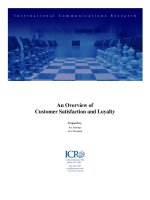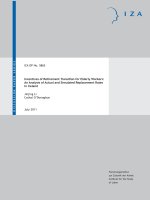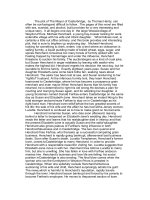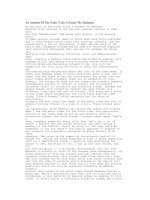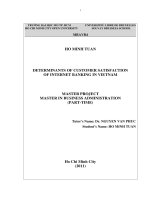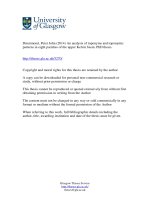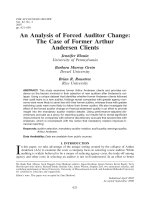An analysis of customer satisfaction at shop go in binh thanh district
Bạn đang xem bản rút gọn của tài liệu. Xem và tải ngay bản đầy đủ của tài liệu tại đây (795.55 KB, 59 trang )
RESEARCH PROJECT
AN ANALYSIS OF CUSTOMER
SATISFACTION AT SHOP & GO IN
BINH THANH DISTRICT
Professor
A. Prof. NGUYEN PHAN
Subject
BMBR5103
Name
DANG HOANG CHIEU HIEN
Class
MBAK15A
Ho Chi Minh 2015
1
Dang Hoang Chieu Hien _ MBA K15A
ADVISOR’S ASSESSMENT
.......................................................................................................................................
.......................................................................................................................................
.......................................................................................................................................
.......................................................................................................................................
.......................................................................................................................................
.......................................................................................................................................
.......................................................................................................................................
.......................................................................................................................................
.......................................................................................................................................
.......................................................................................................................................
.......................................................................................................................................
.......................................................................................................................................
.......................................................................................................................................
......................................................................................................................................
Advisor’s signature
2
Dang Hoang Chieu Hien _ MBA K15A
ACKNOWLEDGEMENTS
To complete this thesis, the author has received a lot of support and help from schools,
agencies, friends and family.
First, I would like to express appreciation and deep gratitude to Prof. Phan Dinh
Nguyen, he has won many precious time to take the guided me during implementation
Thesis.
I sincerely thank all teachers has dedicated teaching, impart valuable knowledge for
me throughout the course.
I also thank him / her for taking the time to interview in the research phase and
preliminary official.
Finally, I would like to thank all the family members have motivation and support me
throughout the course.
TP. HCM, Dec 14 2015
The implementation of the Thesis
Dang Hoang Chieu Hien
3
Dang Hoang Chieu Hien _ MBA K15A
Table of Contents
ABSTRACT ..................................................................................................................................... 6
CHAPTER 1: INTRODUCTION ................................................................................................... 7
1.1 Problem Statement ................................................................................................................ 7
1.2 Research Objectives and Research Subjects ......................................................................... 9
1.2.1 Research Objectives ............................................................................................. 9
1.2.2 Research Subjects ................................................................................................ 9
1.3 Research Questions .............................................................................................................. 10
1.4 Scope of study ...................................................................................................................... 10
1.5 Methodology ........................................................................................................................ 10
CHAPTER 2: LITERATURE REVIEW...................................................................................... 11
2.1 The concept and characteristics of services......................................................................... 11
2.1.1 The concept of services ...................................................................................... 11
2.1.2 The characteristics of services ............................................................................ 11
2.2 Quality service definition ..................................................................................................... 13
2.3 Overview of customers satisfaction ..................................................................................... 14
2.3.1 Customer satisfaction definition ........................................................................... 14
2.3.2 The role and necessity of customers satisfaction ................................................ 14
2.3.3 Some models of customer satisfaction ................................................................ 14
CHAPTER 3: RESEARCH METHODOLOGY .......................................................................... 20
3.1 Research Process .................................................................................................................. 20
3.1.1 Qualitative Research ........................................................................................... 20
3.1.2 Quantitative Research ......................................................................................... 21
3.2 Source of information .......................................................................................................... 23
3.3 Sample and Sample design .................................................................................................. 23
3.4 Adjusting the research model .............................................................................................. 24
3.5 Building scale ....................................................................................................................... 25
3.6 Timing of process research .................................................................................................. 27
CHAPTER 4: EMPIRICAL RESULTS AND DISCUSSION...................................................... 28
4.1 Introduction of the convenient market when shopping at Shop & Go ............................... 28
4.1.1 Introduction to Shop & Go: .................................................................................. 28
4.1.2 Business situation of Shop & Go: ........................................................................ 29
4
Dang Hoang Chieu Hien _ MBA K15A
4.2. Information about the study subjects ................................................................................. 31
4.2.1 Information on age and sex ................................................................................. 31
4.2.2 Information on educations ................................................................................... 31
4.2.3 Assess the level of customer satisfaction ............................................................ 32
4.3 Data Analysis Research ....................................................................................................... 35
4.3.1 Inspection scales................................................................................................. 35
4.3.2 Factor Analysis ................................................................................................... 37
4.3.3 Multiple Regression method ................................................................................ 40
4.4 Discuss .................................................................................................................................. 43
CHAPTER 5: CONCLUSION, RECOMMENDATION AND LIMITATION ........................... 48
5.1 Conclusion ............................................................................................................................ 48
5.1.1 In general ............................................................................................................ 48
5.1.2
For Shop & Go ............................................................................................... 48
5.2 Recommendations ................................................................................................................ 49
5.3 Limitations of the study ....................................................................................................... 49
REFERENCE ................................................................................................................................ 50
THE QUESTIONAIRE INTERVIEW ......................................................................................... 53
5
Dang Hoang Chieu Hien _ MBA K15A
ABSTRACT
The purpose of this study indicated that "customer satisfaction" is the key to the success of
businesses, especially in the retail environment in Vietnam is growing strongly and rapidly
quickly. The study also assess some customer satisfaction’ models such as Kano model, 5Gap Parasuraman’s model and many other models, especially models VCSI apply for the
survey, as well as systems for the questionnaire survey evaluate the main factors impact on
customer satisfaction. Moreover, since the impact of these factors, the study also provides
some solutions to improve the efficiency of service quality for customers and improve
customer satisfaction and customer loyalty when using customer's use of retail services. But
besides that there are some limitations in the assessment even factor in the sampling process,
the use of theory as well as the subjectivity of the process of implementing the survey.
Keywords: Customer Satisfaction, customer loyalty, Convenience store, Customer
saticfaction level
6
Dang Hoang Chieu Hien _ MBA K15A
CHAPTER 1: INTRODUCTION
1.1 Problem Statement
It can be said that we always mention about many methods and forms of business,
commercial introduction, development, processing and finishing of the last stages, different
era. If the previous, the business activities focus primarily on manufacturing, product and
sales. The beginning from the 80s of last century a lot of businesses in the world of business
method transfer to focus on “customer satisfaction” and “customer loyalty”.
During system operation, the client's business is considered a central element on the game
play is particularly important in determining the success or failure of the enterprise. In
countries with economies in developed markets, the general trend is to find ways to satisfy
customers and build customer loyalty for businesses, from which new businesses have unique
insole market the stability maintain in the survival and development.
Therefore, all efforts from production and distribution to sales activities are for the purpose of
satisfying the maximum customer satisfaction.
Customer satisfaction is the key to the success of any enterprise. In the past there have been
many studies assessing and modeling of satisfaction as:
"Model of Customer Satisfaction by Zeithaml & Bitner (1996)" - According to research
by Zeithaml and Bitner (1996), the customer satisfaction is affected by the 5 following key
factors: (1) Service quality, (2) Product quality, (3) Price, (4) Situational Factors, (5) Personal
Factors.
"Model of Satisfaction Index Usa (ACSI)"- Based on the model of Sweden (SCSB) ACSI
model has been developed by Claus Fornell (Fornell et al, 1996). So far ACSI model has
been applied in 10 economic sectors and in 41 different industries.
It can be said evaluation of customer satisfaction is so much aimed at fields, and one of them
for retail service industry, customer satisfaction has been the key factor for the development
of this sector, especially in Vietnam.
Nowadays the trend of economic globalization is developing quickly, the life of the people is
increasing, but their criteria set out in life are more likely to move from "warm and well fed
"through the concept of" good food and nice clothing". So they have a high and increasing
demand for rigorous daily use products, especially for food items. As we all know, the
7
Dang Hoang Chieu Hien _ MBA K15A
current situation of food safety is very complex movements, consumers lose confidence in the
product in a commodity market and the roadsides and finally stops their main supermarkets where consumers can complete peace of mind for the quality of the goods they need.
Currently, the system of supermarkets in Vietnam generally quite developed and extensive
reporting Retail Development Index Global 2006, Kearney has ranked Vietnam ranks 3rd on
the first level of appeal retail investment in thirty retail market.
The results of the Vietnam retailers are encouraging but need to recognize that the challenges
are still a lot of retailers in the country. Especially after Vietnam joined the WTO and
domestic supermarkets starting pressure of the leading supermarket is preparing to penetrate
the Vietnam market. The systems at the international supermarkets and big retail systems
from foreign investors with domestic retail system has helped the retail market in Vietnam is
becoming more active and attractive.
However, in recent years if the previous model of traditional markets with large and small
supermarkets dominate the retail market in Vietnam is now the appearance of the
convenience store system has been threatened to the position of the model, to overcome the
disadvantages of traditional markets as well as supermarkets, convenience stores may be
overtaken on the retail market in the near future.
The first biggest advantage of the convenience stores, in addition to the quality and origin of
the product is a display (focusing on essential goods) and uptime (open almost 24/24). These
stores are located in residential areas intermingled, creating convenient channel for people in
remote capital supermarket and do not want to go to traditional markets, grocery stores.
Secondly, it can be said that traditional markets with consumers tend convenient and fast.
However, consumers in traditional one are exposed many weaknesses as food quality cannot
be guaranteed, there is no clear origin, affecting people's health, particularly special pricing is
not stable ... making people increasingly lost confidence in the food market. So buying in
large supermarkets have become habits of the majority of consumers in major cities,
convenient sales channel has exposed many advantages. In addition to ensuring the quality of
goods, which consumers are assured by stable price, but sometimes the busy work of making
consumers do not have enough time in the big supermarkets and shops whereby utilities are
born and crept in residential areas, roads upon facilities and we have solved the problem of
time as well as concerns about food safety and hygiene of the judging consumer goods.
8
Dang Hoang Chieu Hien _ MBA K15A
SHOP & GO was established on 26 th April 2005 and the company runs the convenience store
chain's largest in Ho Chi Minh City and Ha Noi. The first store of Shop & Go was officially
operational on 3rd December, 2005 at 74A1 Hai Ba Trung Street, District 1, HCMC. From
one store in 2005, currently has 126 Shop & Go stores (June 8th 2015). In the coming years
will continue to Shop & Go system expansion in convenience stores nationwide to meet the
increasing demands of the people of the country.
SHOP & GO gives customers convenient services, consistent with the needs of each
residential area around each store, including automated teller machine ATM, telephone
recharge cards, phone cards long distance IDD card.
For customers of Shop & Go is the aim for convenient and quick in service style; high
quality, new with reasonable prices of products, environment-friendly, clean and modern in
store.
With an area of moderate (60-150 m2) in the attractive location, visible, each shop has more
than 2,000 different types of items, chosen carefully to suit the needs of the people local as
well as tourists.
1.2 Research Objectives and Research Subjects
1.2.1 Research Objectives
With the situation of the retail market in Vietnam and the recent appearance of the system of
the convenient stores for considering the customer satisfaction and the overall goal of these
studies is to examine main factors which affect customer satisfaction. To achieve this overall
goal requires meeting the following specific objectives:
1. Identify the components should be customer satisfaction
2. Through surveys to assess customer satisfaction
3. For a number of solutions to enhance customer satisfaction when using services from Shop
& Go convenience store
1.2.2 Research Subjects
Topics focused on the quality of business, sales of Shop & Go convenience stores, through
which assess the level of satisfaction of customers when shopping at Shop & Go, and
9
Dang Hoang Chieu Hien _ MBA K15A
research subjects is all the customer has used the service at Shop & Go in Binh Thanh
District, Ho Chi Minh City.
1.3 Research Questions
Make this topic we pose the following research questions in order to clarify the research
objectives of this topic:
1. The Factors that create customer satisfaction when you go shopping at the system of
convenient stores like Shop & Go.
2. The Level of customer satisfaction for the elements that like.
3. To raise the level of customer satisfaction, it should have the solution.
1.4 Scope of study
Study of indicators to assess customer satisfaction of residents who shopping and using the
service at Shop & Go in areas at Binh Thanh District, Ho Chi Minh City.
1.5 Methodology
Determining the information to be collected for survey and identifying the information
gathering with 2 types of sources such as primary sources through the interview table for
customer who residents in Binh Thanh district and secondary source from the newspapers,
internet, diagrams and index which were made by the previous studies. In addition, doing the
preliminary studies using qualitative research and qualitative research for the variables which
are determined for the customer satisfaction, all information and data analysis will be
processed by SPSS software.
10
Dang Hoang Chieu Hien _ MBA K15A
CHAPTER 2: LITERATURE REVIEW
In this chapter, the study introduces some basic concepts of service, the characteristics
of services and service quality is how? As well as making the concept of customer
satisfaction and introduce a model of analysis of customer satisfaction in service
research topics
2.1 The concept and characteristics of services
2.1.1 The concept of services
In economics, the service is understood as something similar goods but is immaterial. Philip
Kotler said: "Service is all action and results that a party may give the other party and mostly
intangible and does not result in ownership of something. Is it possible or not tied to a
physical product."
Dr. Nguyen Van Thanh said: "Service is an active creative work to add value to the material
composition and diversity, cultural richness, differentiation, excel that most of ... become the
brand, the business culture and high satisfaction for consumers so that they are willing to pay
high, so business more effectively."
Such services may find that creative activities of human activity has its own specific
characteristics of human social development, there is a highly competitive, with elements of
the technology boom, transparent of law, transparency of government policy.
2.1.2 The characteristics of services
Services can be paraphrased in terms of their key characteristics, sometimes called the "Five
I's of Services"
1. Intangibility
Services are intangible and insubstantial: they cannot be touched, gripped, handled, looked at,
smelled, tasted. Thus, there is neither potential nor need for transport, storage or stocking of
services. Furthermore, a service can be (re)sold or owned by somebody, but it cannot be
turned over from the service provider to the service consumer. Solely, the service delivery
can be commissioned to a service provider who must generate and render the service at the
distinct request of an authorized service consumer.
11
Dang Hoang Chieu Hien _ MBA K15A
2. Inventory
Services have little or no tangible components and therefore cannot be stored for a future use.
Services are produced and consumed during the same period of time.
3.
Inseparability
The service provider is indispensable for service delivery as he must promptly generate and
render the service to the requesting service consumer. In many cases the service delivery is
executed automatically but the service provider must preparatorily assign resources and
systems and actively keep up appropriate service delivery readiness and capabilities.
Additionally, the service consumer is inseparable from service delivery because he is
involved in it from requesting it up to consuming the rendered benefits.
Examples: The service consumer must sit in the hairdresser's shop & chair or in the plane &
seat; correspondingly, the hairdresser or the pilot must be in the same shop or plane,
respectively, for delivering the service.
4. Inconsistency (Variability)
Each service is unique. It is one-time generated, rendered and consumed and can never be
exactly repeated as the point in time, location, circumstances, conditions, current
configurations and/or assigned resources are different for the next delivery, even if the same
service consumer requests the same service. Many services are regarded as heterogeneous or
lacking homogeneity and are typically modified for each service consumer or each new
situation (consumerised).
Example: The taxi service which transports the service consumer from his home to the opera
is different from the taxi service which transports the same service consumer from the opera
to his home – another point in time, the other direction, maybe another route, probably
another taxi driver and cab.
5. Involvement
One of the most important characteristics of services is the participation of the customer in
the service delivery process. A customer has the opportunity to get the services modified
according to specific requirement.
12
Dang Hoang Chieu Hien _ MBA K15A
2.2 Quality service definition
For a long time, many researchers have tried to define and measure the quality of service
quality from the 1930s in the manufacturing sector has been identified as a factor to be
competitive, but the quality factor really becomes important since world War 2nd.
The author pioneer in this field is W.Edwards Deming, Joseph and Kaoru Ishikawa M.Juran.
As the field of new services were developed in recent decades. So to define, evaluate and
manage the quality in this area comes from the manufacturing sector. But the service is
characterized by the invisible; can not weigh, difficult and quality control; heterogeneous
vary by customer, from time to time; can not be separated, especially those services have a
high labor content and can not inventory. Evaluating the quality of service is not easy, for
there remains much debate among theorists and researchers to define, evaluate the quality of
service.
However, the following are definitions and methods of quality assessment are researchers or
mentioned in their study. Lehtinen and Lehtinen (1982) for the quality of service must be
assessed in two ways, (1) the process of service delivery and (2) the results of the service.
Grönroos (1984) also suggested that the two components of service quality, such as (1) the
technical quality, which is what the customer receives and (2) the quality of function,
interpreting services offered What level.
However, when it comes to quality of service, we can not fail to mention the great
contribution of Parasuraman & CTG (1988, 1991). Parasuraman & CTG defined quality of
service is "different levels between the expectations of the consumers of services and their
perceptions of the outcome of the service". These authors have initiated and used qualitative
research and quantitative expertise to build and scale components of quality of service (called
SERVQUAL). SERVQUAL is adjusted and tested in many different types of services.
Finally SERVQUAL scale consists of 22 variables to measure the five components of service
quality, namely: reliability (reliability), responsiveness (responsiveness), calculated guarantee
(assurance), a tangible medium (tangibles) and empathy (empathy).
13
Dang Hoang Chieu Hien _ MBA K15A
2.3 Overview of customers satisfaction
2.3.1 Customer satisfaction definition
Customer satisfaction is the extent of the status of a customer feeling derived from the
comparison of results obtained from the consumer products and services with their previous
expectations. Level of satisfaction will be depended in difference between getting results and
expectations.
If actual results below expectations, customers are not satisfied.
If the actual results match the expectations, the customers will be satisfied.
If actual results higher than expected, the customers are very satisfied.
2.3.2 The role and necessity of customers satisfaction
Customer satisfaction plays a particularly important role in determining the success or failure
of the enterprise. This is the main factor that brought success to business enterprises in any
field. Find out what customers say about your business and what you need to watch for
further improvement, this will ensure that your business is always meet the expectations of
customers.
The study of customer satisfaction is a necessity in business. A Customer Satisfaction Survey
not only help you to recognize the shortcomings of the business, but also to show customers
that you really care about them and wish to find out the optimal way to improve service
quality. Satisfaction, customer satisfaction has affected their loyalty to the brand of the
manufacturer. Actually deciding factor loyalty of customers is the value for customers.
Customer value creates satisfaction - the level of customer satisfaction. Enterprises need to
measure the level of satisfaction of its customers and competitors of the industry. The
information about the reduced level of customer satisfaction of business customers compared
with competitors that signal the loss of customers, reduced market share in the future.
2.3.3 Some models of customer satisfaction
1. Kano’s model
The Kano Model was created in 1984 by Professor Noriaki Kano while studying the
contributing factors to customer satisfaction and customer loyalty. The Professor classified 5
unique categories of customer requirements, 3 of which you want to end up
in your offering, the other 2 should be taken out. This model’s main objective is to help teams
14
Dang Hoang Chieu Hien _ MBA K15A
understand, classify, and integrate these 3 main categories of requirements into the products
or services they are developing. The 5 categories of customer requirements are classified
depending on their ability to create customer satisfaction or cause dissatisfaction. Knowing
what category customer requirements fall into and the importance of each requirement can
help prioritize development activities and determine what to include in your offering and
where to spend resources improving these requirements. The model describes these 5
categories on a set of axis. The y axis is degree of satisfaction of the requirement; the y axis is
the level of fulfillment or execution of the requirement by the company. All 5 categories of
requirements can be mapped on the axis.
Kano also designed a special survey now known today as the Kano Survey. It can be
designed and used to categorize all the requirements. In this survey, you formulate two
strategic questions, a functional and dysfunctional representation of the requirement.
Depending on how the respondents answer the question, the results will be aggregated and
compiled into a graph which clearly shows you which category the requirement/feature falls
into. Using this information along with some other voice of customer data, the development
team can find gaps in their offering and potential holes in their customer research.
Understanding how the list of requirements fits into the Model can also help a development
team determine which of the requirements or features to include, which need enhancement,
which need cost reduction, which should be excluded, and which to simply leave alone.
2. “5-Gap” Model of Parasuraman
One of the basic characteristics of service quality is difficult to measure, difficult to define
quality standards, it depends on the human factor is largely. Quality of service quality is
above all human. Products and services are intangible. Quality of service is defined by the
customer, not by the supplier. Customers evaluate the quality of the services provided
through the assessment of the service personnel of the company and through his subjective
feelings.
For the products and services of the supermarkets in general and of the system's convenience
stores Shop & Go in particular, we can measure the quality of service by the unique
characteristics of the products are based on image quality services Parasuraman.
GAP 1: occurs when there is a difference between customer expectations of service quality
and administrator perceived expectations of customers. The fundamental point of this
15
Dang Hoang Chieu Hien _ MBA K15A
difference is due to service companies not understanding fully what characteristics make up
the quality of their services and how they are delivered to customers to meet their needs.
GAP 2: occurs when services firms have difficulty in changing their perceptions of customer
expectations of service characteristics. The main cause of this problem is the professional
competence of staff services.
GAP 3: occurs when employees transfer service to the customer service according to the
criteria were identified. During the service, the staff direct contacts with clients and play an
important role in the process of creating quality. However, not always and all employees are
able to complete tasks according to the criteria set out.
GAP 4: advertising media and information and the impact on customer expectations of
service quality. The promise of advertising, promotions can increase the expectations of
customers, but also reduces the quality that customers feel when they do not comply with
what was promised.
GAP 5: occurs when there is a difference between the quality expected by the customer and
the quality they perceive. The quality of service depends on the distance this Thursday, when
customers see no difference between the quality they expect and the quality they perceive as
a consumer service, the quality of services considered perfect. Parasuraman said that service
quality is a function of the gap 5th. The gap 5th depends on the previous distance, ie the
distance of 1, 2, 3, 4. So to shorten the the gap 5th or increase service quality, service
managers must attempt to shorten the gap.
4. Model of customer satisfaction functional relations
Customer satisfaction is composed of two components:
. Satisfying function: the satisfaction achieved by purchasing any goods or services quality
with reasonable price.
. Relationship: relationships are in prison "process business transactions accumulated over
time as trust in service providers, qualifications of staff, Customer service attitude
...Satisfaction and relationship function is influenced by the following factors:
(1) Price: The value of the product or service value shall be converted into cash. Prices
depend on many factors such as quality, brand, service comes ... the trend of consumers today
16
Dang Hoang Chieu Hien _ MBA K15A
is that they are willing to pay a high price substrate inhibition receive a product or service
good quality. Factors à interested customers are price matches the quality or not. Therefore,
the price has certain influence to the satisfaction of the Customer.
(2) Product quality: based on the following characteristics:
Performance: operating characteristics or the basic functionality of the product.
Features: In addition, the basic functions and features that increase the attractiveness of the
service.
Reliability: the probability of successful implementation of a function defined in a defined
time period and under the conditions specified. The reliability of the product is usually
measured by the average time first appeared damaged or average time between visits
damaged. However, these measurements require the product to be used in a defined time
period and it is not appropriate in cases where products and services are used or the consumer
immediately.
Conformance: the extent to which the design and operating characteristics of the product
comply with the standards set out.
Durability: product life. Reliability can be defined as the time to use the product before it is
reduced to a value that must be replaced without repair.
Serviceability: ability, attitude and level of courtesy in the repair quickly. Repair costs are
not just paying money to repair. It covers all aspects of the loss and inconvenience caused by
downtime of equipment, the attitude of the service team, and the number of times failed to fix
a problem.
Aesthetics: how the product looks, feels, sounds, smell or taste of the product is. Aesthetic
depends are very much on individual preferences. This is a subjective attribute high
Perceived Quality: the reputation of a company. Customers do not always have complete
information about the characteristics of the products or services; in which case the reputation
of the company is the sole basis for them to compare between brands
(3)Quality of service: based on the following characteristics:
Reliability: Ability to perform the promised service properly and accurately.
17
Dang Hoang Chieu Hien _ MBA K15A
Response: The ready to help Customer quickly and begin providing services.
Assurance: the quality of the staff will create Customer confidence: professionalism,
courtesy, respect for Customer, the ability to communicate,
Empathy: Waiter approachable style: attention to Customer, feeling assured...
Tangibility: appearance of physical facilities, equipment, personnel, items, materials used
for communication.
(4) & (5) Related services and quality of relations: factors relating to professional
qualifications, attitude of staff ... to comply with what was committed, prestigious Customer
... will affect Customer satisfaction.
4. Customer Satisfaction Index – CSI
CSI is a model consisting of variables causes - results: brand image, quality expectations,
perceived quality, Customer satisfaction and loyalty. Customer satisfaction is placed in the
relationship between cause and outcome variables of the model. Usually CSI 4 variables
starting with: brand image, quality expectations, perceived quality, perceived value, and
meanwhile, Customer satisfaction will create loyalty (if Customer satisfied) or that the
complaint (if Customer is not satisfied).
That means: the satisfaction of customers that led to the extreme sense for Customers are:
(1) Be satisfied with the quality of products / services and tend loyal to the brand or that
brand or
(2) There is much dissatisfaction whore product / service behaviors lead to "negative" brand.
Model VCSI - Customer Satisfaction Index Vietnam certainly is not out corruption rules on
standards. To exploit these factors affect the model, the study will propose VCSI model with
7 variables.
The causal variables in the model include:
(1) Brand image
(2) The quality expectations
(3) Perceived Quality
18
Dang Hoang Chieu Hien _ MBA K15A
(4) Value comments
(5) Customer satisfaction (central element)
The outcome variable of the model is:
(6) The complaint
(7) Customer loyalty.
In Vietnam, VCSI theoretical model is set up as follows The measurement factors include:
Potential Variables
Caused Variables
Variable causes
Brand image
Factors measurement
General impression of the brand image
Characteristic or outstanding level of
differentiating characteristics of the brand
Quality
Quality expectations (an overview)
expectations
Quality expectations of the requirement of
Customer
Quality expectations really
Quality of service expectations
Perceived Quality
Perceived quality (in general)
Perceived quality on demand or perceived level
of product
Quality feel really
Perceived Quality of Service
Perceived Value
Quality assessment by price
Quality assessment on the quality
The central variables Customer
Satisfaction
Satisfying an overview of the product
Does not meet expectations
Satisfied in comparison with other brands
The distance to the ideal product
The outcome
The complaining
Not satisfied with the supply of products /
variables
customer
services
The specific requirements are not met
19
Dang Hoang Chieu Hien _ MBA K15A
CHAPTER 3: RESEARCH METHODOLOGY
From the above data analysis, this part will outline the procedures for quantitative
analysis and qualitative analysis, taking the information source for research, sampling,
adjusting the sample, choosing scales for the essentials of study customer satisfaction
and how to select variables for this study
3.1 Research Process
3.1.1 Qualitative Research
The process is done by the interview questions directly to customers when shopping at Shop
& Go. The purpose of this process is to review and evaluate the factors affecting customer
satisfaction when using the services of Shop & Go.
These factors are:
1. Reliability
2. Responsiveness
3. Assurance
4. Empathy
5. Tangibles
6. Price
7. Waiting time
The customer will be interviewed all those shopping at Shop & Go in the area of Binh Thanh
District, Ho Chi Minh City.
The contents of the interview: check the suitability of the elements drawn from theory and
from the shopping situation in Binh Thanh District, Ho Chi Minh City, the elements drawn
from the theory will be considered if it really works action to the satisfaction of the customer
or not, if less important factor may be removed from the model can also complement factor
deficiencies. After clarifying the elements, we will examine and highlight the concepts of
measurement factors affecting satisfaction that the author has drawn.
20
Dang Hoang Chieu Hien _ MBA K15A
3.1.2 Quantitative Research
1. Objectives: The objective of quantitative research to measure the customer's perception of
factors have been identified in qualitative research
2. Methods of collecting information
Quantitative data were collected through interviews with customers detailed questionnaire
was designed in accordance with the research objectives. The questionnaire was designed
based on the results of qualitative research. There will be a questionnaire based on a number
of test pieces interview conducted before formal study. The purpose of the interview is to try
to correct some errors and eliminate the confusing factor for interview subjects.
3. The steps of data analysis.
Adjustment: Aim to ensure the correct object editing, processing the uncompleted answer,
consider clear answers from the questions.
The process of adjustment is via 3 stages:
1. Doing after trial samples were used and gotten the good result
2. Edited by investigators after the interview is completed
3. Edited by the researchers, who also designed the questionnaire table Encryption, cleaning
information Data were coded variables, data entry and cleaning before processing to detect
errors or invalid answers. Information collected will be processed SPSS software
Methods of analysis
1. Method of descriptive statistics:
Be used to analyze the development of the Shop & Go system, characterized respondents.
Implementation of descriptive statistics for the variables observed, for all customer groups,
calculated for each group of variable frequency and sample size
2. Method Cronbach alpha reliability coefficient and factor analysis to explore
EFA:
It is used to test the scale of the factors affecting the quality of service. The scale of this
method is determined by the two methods
21
Dang Hoang Chieu Hien _ MBA K15A
Method 1: Analysis Cronbach's alpha coefficients
This method analyzes the reliability of Cronbach's alpha coefficient to remove inappropriate
variables. These variables have a correlation coefficient item - total correlation is less than
0.3 are discarded, and the standard scale reliability Alpha 0.6 or higher (Nunnally &
Burnstein 1994)
Method 2: Analysis discover EFA factor is used, the variables Factor loading is less than 0.5
will continue to be removed In the method of factor analysis to explore, extract coefficient
method using Principal Component Analysis method and Varimax rotation to group
elements, after each subgroup must proceed to consider two criteria is the some KMO
(Kaiser_Mayer_Olkin) must be greater than 0.6 and factor loading coefficients in Table
Rotated component Matrix must have a value greater than 0.5 to ensure piggledy
convergence between the variables in the first factor, and points used to extract factors must
with Eigenvalue greater than 1. the scale is acceptable to deduct the total variance is greater
than or equal to 50%
3. Multivariate regression model:
Be used to identify the factors that affect customer satisfaction and assess the impact of these
factors to the satisfaction of the customer to the system of Shop & Go convenience store in
the county Binh Thanh, Ho Chi Minh City. Multivariate regression models extend the two
variables regression model by adding an independent variable to better address the dependent
variable. The model takes the following form:
Yi= B0 + B1Xi + B2X2i + … + BpXpi + ei
Among them:
Yi : dependent variable
Xpi : expression values of the independent variables pth observation in the ith
Bk: Partial regression coefficient
ei: are independent random variables with normal distribution mean 0 with covariance is 2
22
Dang Hoang Chieu Hien _ MBA K15A
3.2 Source of information
1. Secondary Information: Information collected includes the development of systems of
convenience stores in recent years, especially the system of convenience stores Shop & Go
through resources from: newspapers, magazines, websites, the data reported by the
departments and branchs, especially in Binh Thanh District, Ho Chi Minh City
2. Primary information: Collected from the questionnaires from the customer once the
procurement and use of services at Shop & Go, including factors affecting customer
satisfaction for the door convenience stores, customer perception of factors, and demographic
information of the object to be interviewed
3.3 Sample and Sample design
1. Sampling Samples were selected based on non-probability method based on any customers
who purchase and use the services of Shop & Go, the interview was carried goods in
supermarkets
2. Sample design Sampling frame: the customer had walked Shop & Go, frame is designed
by methods of non-probability sampling Because this research topics satisfy the customer,
that customer volume went Shop & Go is very large and difficult to find the right size to form
the group we decided to design as follows: Sample size is determined by the minimum
guidelines to achieve the necessary confidence in the research. What minimum sample size is
currently still many different idea of researchers, have not been agreed and came to the
conclusion such as MacCallum and his colleagues (1990) have summarized the research on
sampling of the previous studies and summarized the minimum sample size for factor
analysis.
According to Kline (1979) the minimum is 100, Guiford (1954) said that 200 is suitable for
sample size. While Corney and Lee (1992), given the sample size with the respective views:
Sample size = 100: Bad
Sample size = 200: Quite
Sample size = 300: Good
Sample size = 500: Very Good
Sample size> = 1000: Excellent
23
Dang Hoang Chieu Hien _ MBA K15A
This study will be sampled according to the principles of Corney and Lee (1992), the sample
size was determined to be 300 (the level of Quite).
3.4 Adjusting the research model
Actual comments from the experts we will draw a lot of factors that strongly influence
customer satisfaction, but besides that there will be one of the changes and supplements as
well as eliminate unnecessary elements. Using the 5 components of SERVQUAL are the
components needed for research, surveys of customer satisfaction, however, need to have one
of those adjustable to suit the supermarket sector to help customers easily Read more in an
interview. 1 in 5 of adjusting the composition of the SERVQUAL scale should be made
goods, specifically when it comes to reliability, customers often think of the goods, the goods'
origin, provenance, quality of goods, the so the reliability of the model should be adjusted
component of Goods (1)
Also when it comes to India and India meet the experts ensure that customers are often
interested in the serving attitude of staff (2).
The next factor is empathy is also identified as the customer is concerned, however,
according to experts, factors other customers vague and not very interested in this, so
empathy are excluded from the model.
Most experts agree that physical element means a huge impact to customer satisfaction,
customer loyalty and tendency to understand the tangible media as the base material. So the
tangible reality will be adjusted to the Facilities (3) The last two factors are prices (4) also
have a huge impact to the customer's satisfaction, but the waiting time factor is pretty vague,
mainly occurs when the peak shopping hours, at certain times of the year, so this factor is
excluded. In addition to the above elements of the SERVQUAL model to examine the first
number of other factors which are interested in promotions (5) and other support services (6)
Such models would need to adjust the following form:
H1: quality goods that affect customer satisfaction
H2: The service attitude of the staff that affect customer satisfaction
H3: The facilities at the Shop & Go that affect customer satisfaction
H4: Prices of commodities that affect customer satisfaction
24
Dang Hoang Chieu Hien _ MBA K15A
H5: The promotion of supermarkets that affect customer satisfaction or not
H6: Support Services of supermarkets that affect customer satisfaction
3.5 Building scale
The result of qualitative research is the basis for the construction of the questionnaire in
quantitative research. The scale used in this study is Linkert 5 point scale, used for
quantitative variables. Level 1 is "Strongly disagree" to 5 being "Strongly agree"
1. Scale factor "Goods" According to the results of a qualitative study, the customers
are very interested in the quality of goods according to the following criteria:
Diversity of goods, merchandise guaranteed shelf life and ensure food safety criteria
(safety Winemaking), labeling and origin. Elevator quality merchandise that includes
four observed variables from G1 to G4 symbols. These variables are often measured
by LINKERT 5 points:
G1: Goods diversity for choosing
G2: Goods assure timely and safe use of food hygiene and safety standards (VSATTP)
G3: Goods labeled, clear origin
G4: Goods sold in Shop & Go is the product of good quality
G5: Always have many new items on display
2. Factors "The attitude of staff"
Through the interview process can see customers are interested in style and service attitude of
the staff can speak as: agility in the service, friendly staff or not ?, costume employee with
neat, elegant or not? ... the Attitude Scale consists of 5 Staff of the observed variables from
TAOS1 to sign TAOS5, these variables were also measured by LINKERT 5 points.
TAOS1 The staff is always ready to serve customers
TAOS2 Staff mobility
TAOS3 Dedicated staff to answer customer questions
TAOS4 Staff were friendly and fun
25
Dang Hoang Chieu Hien _ MBA K15A
